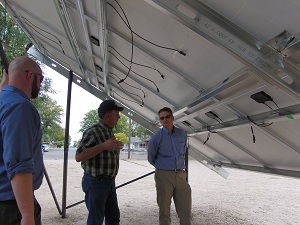New green economy may face employee shortage
 Companies and governments are promising to go on hiring sprees to support their new green economies, but a newly-released study indicates that they may have trouble getting qualified applicants.
Companies and governments are promising to go on hiring sprees to support their new green economies, but a newly-released study indicates that they may have trouble getting qualified applicants.
The jobs promise to be good ones. That’s not the problem. The problem, according to a report from the Association of Energy Engineers, is that there may not be enough skilled labor trained to handle the new jobs.
“From a U.S. perspective, we have a lot of work to do to train our workforce for these new green collar jobs,” said Brian Douglas, director of business development for the Association.
His organization, which boasts 14,000 members who work in the energy industry, conducted a survey of its members with more than 10 percent responding. Sixty-two percent of those surveyed said they currently are or have considered installing renewable energy technologies, according to a report on the survey. Sixty-seven percent said they believe there is a shortage of energy management practitioners now, and 37 percent said they plan to retire within the next 10 years.
There are announcements every day about major solar projects being installed at businesses, homes and government buildings. Major utility-scale projects are being approved at a rapid pace. The largest solar plant in the world was approved Monday for the Mojave Desert. Nearly every one of those news stories includes some high number of jobs that will be created by the specific projects.
But someone has to build the structure, install the photovoltaic panels, and hook them up to the electric grid.
“If this country is going to do this,” Douglas said, “which it is—it is doing this—then we’re going to need a lot of infrastructure.”
He said people need to be trained to hook these new renewable energy systems up to the grid.
Knowing that there is going to be a shortage of skilled labor is the first step in finding a solution. The Association of Energy Engineers has worked hard to develop new and innovative training programs, working with employers like General Motors and governments like Georgia’s, Douglas said. The Association has also been working with technical trainers in Alaska and promoting community college programs.
Major-four-year universities like The University of California, Davis, have also been incorporating green energy elements into their engineering programs, Douglas said.
“The hope is that those students will take it one step farther,” Douglas said, “and upon graduating, actually enter the green energy industry.”
One worry is that the industry could be so flooded with jobs and behind on supplying the labor force with trained, qualified employees, that a backlog develops the way it has in the nursing industry where school and programs can’t get enough trainers to grow their programs fast enough to graduate the next generation of professionals.
“The question is,” Douglas said, “how do we create a pathway for these professionals?”
Pictured: Vibrant solar consultants Ben Jones and Chris Hamilton, talk to local Richard Jensen under a newly installed array in Fowler, Colo.



